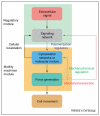Computational approaches for modeling regulatory cellular networks
- PMID: 15564042
- PMCID: PMC3619405
- DOI: 10.1016/j.tcb.2004.10.007
Computational approaches for modeling regulatory cellular networks
Abstract
Cellular components interact with each other to form networks that process information and evoke biological responses. A deep understanding of the behavior of these networks requires the development and analysis of mathematical models. In this article, different types of mathematical representations for modeling signaling networks are described, and the advantages and disadvantages of each type are discussed. Two experimentally well-studied signaling networks are then used as examples to illustrate the insight that could be gained through modeling. Finally, the modeling approach is expanded to describe how signaling networks might regulate cellular machines and evoke phenotypic behaviors.
Figures




Similar articles
-
Modeling cell signaling networks.Biol Cell. 2004 Jun;96(5):355-62. doi: 10.1016/j.biolcel.2004.03.004. Biol Cell. 2004. PMID: 15207904 Free PMC article. Review.
-
Modeling of signaling networks.Bioessays. 2002 Dec;24(12):1110-7. doi: 10.1002/bies.1154. Bioessays. 2002. PMID: 12447976 Review.
-
Dose-response modeling in reproductive toxicology in the systems biology era.Reprod Toxicol. 2005 Jan-Feb;19(3):327-37. doi: 10.1016/j.reprotox.2004.12.004. Reprod Toxicol. 2005. PMID: 15686868 Review.
-
Modeling signaling networks with different formalisms: a preview.Methods Mol Biol. 2013;1021:89-105. doi: 10.1007/978-1-62703-450-0_5. Methods Mol Biol. 2013. PMID: 23715981
-
A computational tool for Monte Carlo simulations of biomolecular reaction networks modeled on physical principles.IEEE Trans Nanobioscience. 2010 Mar;9(1):24-30. doi: 10.1109/TNB.2009.2035114. Epub 2009 Nov 3. IEEE Trans Nanobioscience. 2010. PMID: 19887331
Cited by
-
Hope for Humpty Dumpty: systems biology of cellular signaling.Plant Physiol. 2010 Feb;152(2):470-9. doi: 10.1104/pp.109.151266. Epub 2009 Dec 23. Plant Physiol. 2010. PMID: 20032076 Free PMC article. No abstract available.
-
Quantifying the roles of space and stochasticity in computer simulations for cell biology and cellular biochemistry.Mol Biol Cell. 2021 Jan 15;32(2):186-210. doi: 10.1091/mbc.E20-08-0530. Epub 2020 Nov 25. Mol Biol Cell. 2021. PMID: 33237849 Free PMC article.
-
Bayesian parameter estimation for dynamical models in systems biology.PLoS Comput Biol. 2022 Oct 21;18(10):e1010651. doi: 10.1371/journal.pcbi.1010651. eCollection 2022 Oct. PLoS Comput Biol. 2022. PMID: 36269772 Free PMC article.
-
Insights into the organization of biochemical regulatory networks using graph theory analyses.J Biol Chem. 2009 Feb 27;284(9):5451-5. doi: 10.1074/jbc.R800056200. Epub 2008 Oct 20. J Biol Chem. 2009. PMID: 18940806 Free PMC article. Review.
-
Conceptual Evolution of Cell Signaling.Int J Mol Sci. 2019 Jul 4;20(13):3292. doi: 10.3390/ijms20133292. Int J Mol Sci. 2019. PMID: 31277491 Free PMC article. Review.
References
-
- Hartwell LH, et al. From molecular to modular cell biology. Nature. 1999;402:C47–C52. - PubMed
-
- Lum L, Beachy PA. The Hedgehog response network: sensors, switches, and routers. Science. 2004;304:1755–1759. - PubMed
-
- Zhu H, et al. Global analysis of protein activities using proteome chips. Science. 2001;293:2101–2105. - PubMed
-
- Uetz P, et al. A comprehensive analysis of protein–protein interactions in Saccharomyces cerevisiae. Nature. 2000;403:623–627. - PubMed
-
- Ho Y, et al. Systematic identification of protein complexes in Saccharomyces cerevisiae by mass spectrometry. Nature. 2002;415:180–183. - PubMed
Publication types
MeSH terms
Grants and funding
LinkOut - more resources
Full Text Sources

